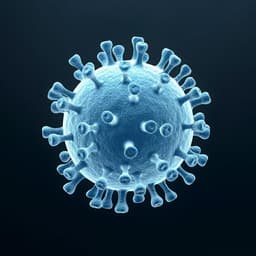
Medicine and Health
The spike of SARS-CoV-2 promotes metabolic rewiring in hepatocytes
M. Mercado-gómez, E. Prieto-fernández, et al.
This groundbreaking study reveals how SARS-CoV-2 affects liver health, showing that the virus can infect hepatocytes and disrupt normal metabolic processes. With over 50% of COVID-19 patients experiencing liver dysfunction, researchers demonstrated that metformin could be a viable treatment option for those affected. This vital research was conducted by Maria Mercado-Gómez and colleagues at CIC bioGUNE.
~3 min • Beginner • English
Introduction
COVID-19 frequently presents with elevated hepatic transaminases (~50% of patients), a marker of disease severity. Potential contributors include antiviral and adjunctive drug-induced liver injury and systemic inflammation, but whether SARS-CoV-2 directly infects hepatic cells remains unclear. Prior coronaviruses (SARS-CoV, MERS-CoV) exhibit hepatic tropism, and coronavirus-like particles have been observed in liver biopsies of COVID-19 patients with apoptosis and mitochondrial swelling, though limited sample sizes restrict interpretation. SARS-CoV-2 entry depends on ACE2 and is facilitated by TMPRSS2 and Neuropilin-1 (NRP1). In metabolic-associated fatty liver disease (MAFLD) and type 2 diabetes, hepatic ACE2 and TMPRSS2 correlate with NAFLD Activity Score, and chronic liver disease (~10% of COVID-19 patients) associates with worse outcomes. Metformin is widely used in T2D, with debated benefits in COVID-19. This study investigates whether hepatocytes are susceptible to SARS-CoV-2 spike-mediated infection, how this affects hepatocyte metabolism (including mitochondrial function and glycolysis), how RAS balance modulates susceptibility, and whether metformin modulates entry factors and infection, particularly under steatotic conditions.
Literature Review
Background studies identify ACE2 as the primary entry receptor for SARS-CoV-2, with TMPRSS2 and NRP1 aiding entry. Clinical observations report abnormal liver tests in COVID-19, with potential causes including drug-induced liver injury and systemic effects. Prior reports using immortalized hepatoma cells and organoid models suggest possible hepatic susceptibility to SARS-CoV-2 and higher ACE2 expression in cholangiocytes than hepatocytes; viral particles have been detected in hepatocytes from COVID-19 autopsies. In MAFLD and obesity/T2D, increased hepatic ACE2/TMPRSS2 expression and worse COVID-19 severity have been reported. The ACE2/ANG(1-7)/Mas axis modulates mitochondrial function and liver injury, and metformin impacts mitochondrial Complex I activity and AMPK signaling, with suggested benefits in COVID-19 outcomes.
Methodology
- Cell models: Human THLE-2 hepatocytes; upcyte second-generation human hepatocytes; primary hepatocytes isolated from humanized ACE2 (hACE2) transgenic mice and wild-type mice. Vero E6 and HEK293T used for controls/virus production.
- Virus: Lentiviral pseudotyped particles expressing full-length SARS-CoV-2 spike (and control pseudovirus without spike). Infection MOI ~0.8 for 48 h. ZsGreen reporter quantified infection by flow cytometry.
- Binding assays: Flow cytometry to assess binding of biotinylated RBD to cell surface; pull-down assays using biotinylated S1 or RBD with neutravidin beads followed by immunoblotting for ACE2, NRP1, TMPRSS2.
- Protein analyses: Western blotting for ACE2, NRP1, TMPRSS2, phospho-AMPKα (Thr172), β-actin loading.
- Proteomics: LC-MS/MS (timsTOF Pro with PASEF, EVOSEP ONE) of primary hepatocytes ± spike-pseudovirus. Protein ID/quantification via PEAKS; analysis in Perseus; differential expression; GO/KEGG enrichment (DAVID). Criteria: ≥2 peptides, FDR <1%; statistics by t-test/ANOVA with volcano plots and heatmaps.
- Bioenergetics: Seahorse XFe24 extracellular flux analyses measuring OCR and ECAR in primary hepatocytes ± infection.
- ROS and apoptosis: MitoSOX Red imaging for mitochondrial ROS; caspase-3 activity assay with fluorogenic substrate.
- Metabolites and fluxomics: Extracellular and intracellular ATP (luminescence), extracellular L-lactate (colorimetric), intracellular glucose; 13C-glucose tracing (10 mM [U-13C]-glucose for 6 h) with UPLC-ToF-MS, isotopologue analysis for glycolysis/TCA intermediates and citrate/glucose labeling ratios.
- Gene expression: qPCR for glycolysis and glutamine metabolism genes (G6PDH, PKLR, PFKL, LDHA, LDHB, GLS1, GLS2, GLUL) and iron transporters.
- RAS modulation: ELISA for extracellular ANG(1-7); pharmacological Mas receptor inhibition with A779 (0–10 μM) ± infection; assess infection, ROS, ATP.
- Steatosis and metformin: Induce steatosis by methionine–choline deficient (MCD) medium; treat with metformin (1 mM) ± MCD; assess ACE2/NRP1/TMPRSS2 expression, infection rates, ANG(1-7).
- Statistics: Student’s t-test or one-way ANOVA; data presented as mean ± SEM; p<0.05 considered significant.
Key Findings
- Hepatocyte susceptibility and spike binding: THLE-2 human hepatocytes express ACE2, TMPRSS2, and NRP1; RBD binds comparably to Vero E6; pull-down confirms S1/RBD binding to ACE2. THLE-2 cells are infectable by spike-pseudotyped lentivirus (flow cytometry ZsGreen).
- Primary hepatocytes: hACE2 mouse primary hepatocytes show higher ACE2 and NRP1 than WT; S1/RBD bind ACE2 in primary hepatocytes. hACE2, but not WT, hepatocytes are infected by spike-pseudovirus; upcyte human hepatocytes are infectable. Infection with spike-pseudovirus decreases ACE2 protein in hACE2 hepatocytes and alters ACE2 pattern in human hepatocytes; spike-dependent caspase-3 activation indicates apoptosis.
- Proteomics: hACE2 hepatocytes exposed to spike-pseudovirus show 354 differentially expressed peptides vs. 132 in WT. Unique pathways altered in hACE2 include response to virus, inflammatory/immune signaling, receptor-mediated endocytosis, mitochondrial translation, cholesterol/steroid metabolism, and iron homeostasis (upregulated NGAL, TFR2, TMPRSS6). KEGG highlighted ribosome and COVID-19-related processes.
- Metabolic rewiring: Spike-pseudovirus increases ECAR and OCR in hACE2 and human hepatocytes, indicating a shift to an energetic, glycolytic phenotype; AMPKα Thr172 phosphorylation increases. Mitochondrial ROS increases; extracellular ATP increases (intracellular ATP unchanged). 13C-glucose flux shows increased glycolytic flux into TCA (increased labeled citrate, fumarate, malate; elevated citrate/glucose labeling ratios). Extracellular lactate increases; intracellular glucose decreases; glycolysis and glutamine genes upregulated.
- RAS axis: Infection reduces extracellular ANG(1-7) in human hepatocytes, consistent with ACE2 engagement. Mas receptor blockade with A779 increases infection in hACE2 and human hepatocytes, elevates mitochondrial ROS and alters ATP, phenocopying infection-driven metabolic effects without increasing apoptosis at 0.1–1 μM A779.
- Steatosis increases susceptibility: MCD-induced steatosis elevates ACE2 and NRP1 (and TMPRSS2 transcripts) in hACE2 and human hepatocytes in a time-dependent manner; steatotic hepatocytes show higher infection rates.
- Metformin reduces entry factors and infection: Metformin (1 mM) decreases ACE2 and NRP1 proteins (and Ace2/Nrp1/Tmprss2 transcripts) in hACE2 hepatocytes over time and reverses MCD-induced increases to near control; similarly effective in human hepatocytes. Metformin reduces elevated infection rates in steatotic hACE2 and human hepatocytes. Under steatosis, ANG(1-7) is increased and is reduced by metformin, consistent with reduced oxidative stress and ACE2 levels.
Discussion
The study demonstrates that primary hepatocytes, both human and from hACE2 mice, are targets for SARS-CoV-2 spike-mediated entry, addressing a key question regarding hepatic susceptibility in COVID-19. Spike engagement of ACE2 on hepatocytes triggers metabolic reprogramming characterized by increased glycolysis and mitochondrial activity with elevated ROS, aligning with observed mitochondrial dysfunction and iron homeostasis alterations in proteomics. The imbalance of the RAS axis upon ACE2 engagement (lower ANG(1-7)) contributes to mitochondrial stress; pharmacological inhibition of the Mas receptor exacerbates infection susceptibility and metabolic disturbances, supporting a mechanistic link between RAS signaling and hepatocyte vulnerability. Metabolic comorbidities (MAFLD/steatosis) increase ACE2/NRP1/TMPRSS2 levels and infection susceptibility, providing a mechanistic basis for worse COVID-19 outcomes in these patients. Metformin downregulates viral entry factors and reduces infection rates in steatotic hepatocytes, offering a plausible explanation for reported clinical benefits in certain COVID-19 cohorts with T2D/MAFLD. Overall, the findings connect spike-ACE2 interaction to hepatocyte metabolic rewiring and suggest therapeutic modulation of metabolism and RAS signaling could mitigate hepatic involvement in COVID-19.
Conclusion
Hepatocytes are susceptible to SARS-CoV-2 spike-mediated infection, which induces a metabolic shift toward glycolysis and mitochondrial dysfunction with increased ROS and altered iron homeostasis. Steatotic hepatocytes exhibit elevated ACE2/NRP1/TMPRSS2 and are more vulnerable to infection. Disruption of the ACE2/ANG(1-7)/Mas axis heightens susceptibility and metabolic stress, while metformin reduces entry factor expression and infection, particularly under steatotic conditions. These results suggest metformin as a potential adjunct to attenuate hepatic infection risk in patients with MAFLD/T2D and underscore targeting metabolic and RAS pathways as strategies to mitigate liver involvement in COVID-19. Future work should evaluate in vivo infection and replication dynamics in liver tissue, assess long-term hepatic consequences, and test metabolic/RAS-targeted interventions in clinical settings.
Limitations
No dedicated limitations section was provided. The study uses pseudotyped lentiviral particles expressing SARS-CoV-2 spike rather than live virus, and relies on in vitro models (primary human hepatocytes and primary hepatocytes from hACE2 mice). In vivo hepatic infection/replication and clinical validation were not addressed.
Related Publications
Explore these studies to deepen your understanding of the subject.







